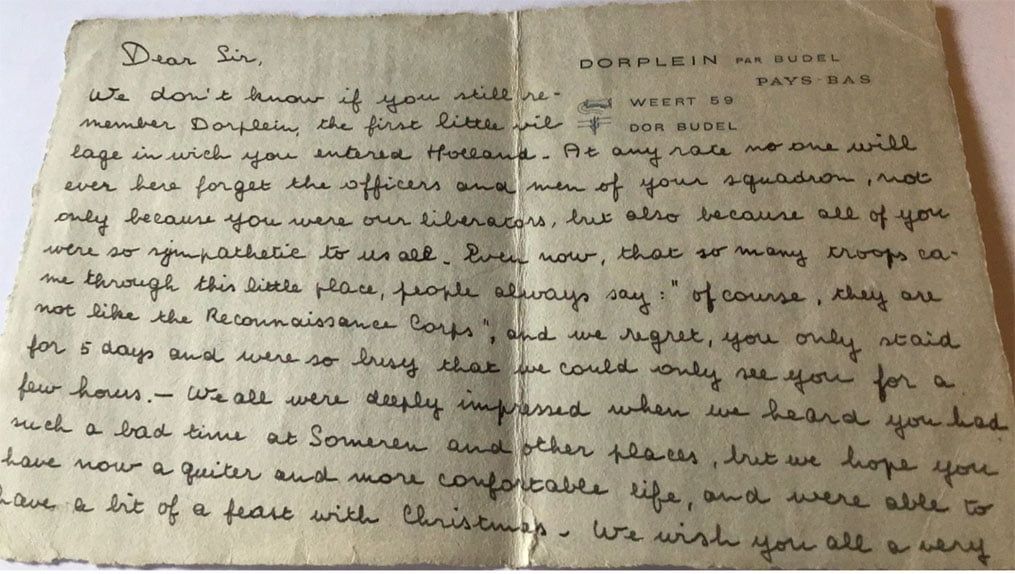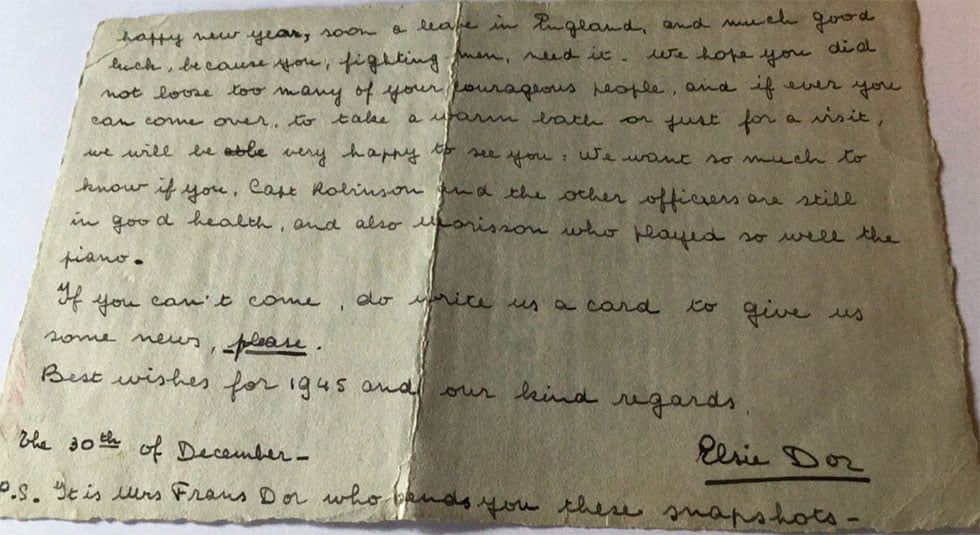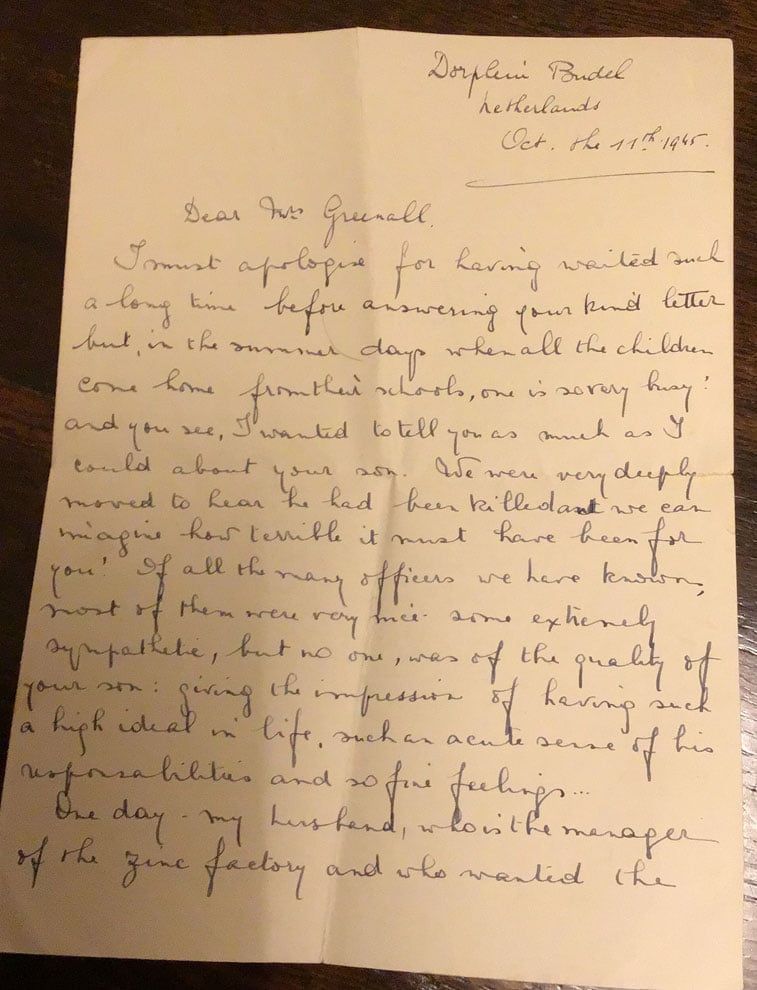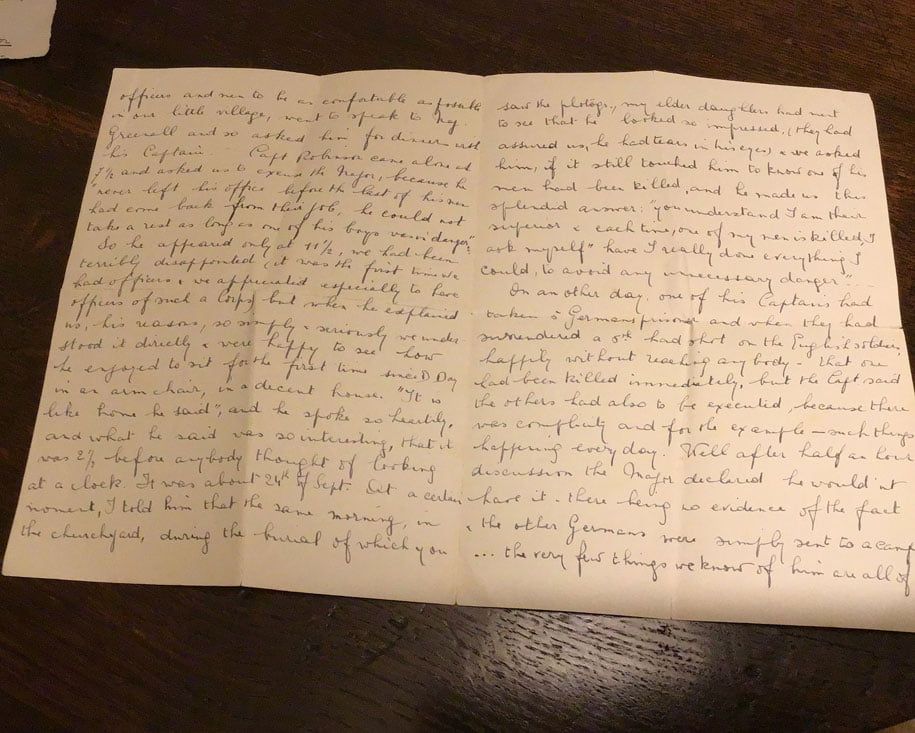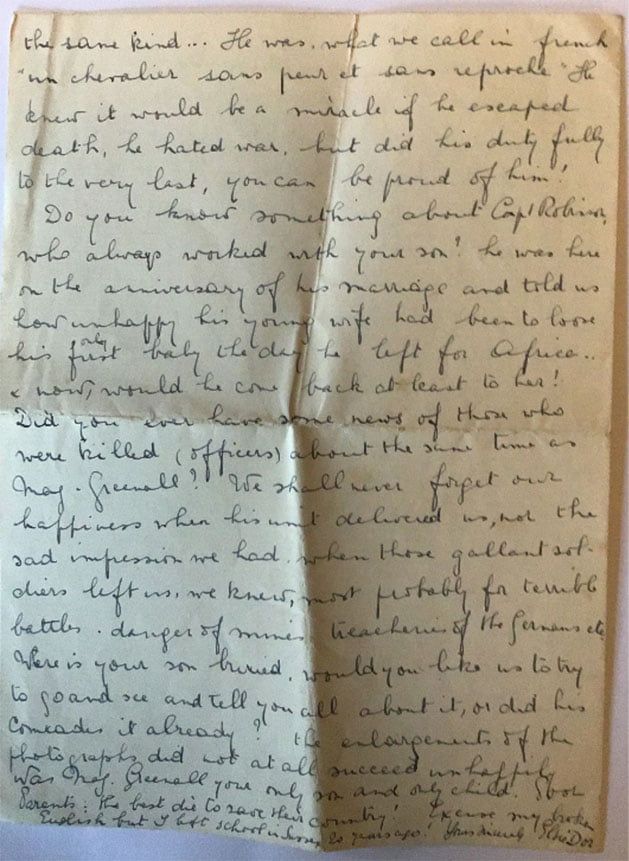Greenall | Terence Haigh
- First names
Terence Haigh
- Age
24
- Date of birth
21-05-1920
- Date of death
29-10-1944
- Service number
189578
- Rank
Major
- Regiment
Reconnaissance Corps, R.A.C., 3rd (8th Bn. The Royal Northumberland Fusiliers) Regt.
- Grave number
II. A. 2.
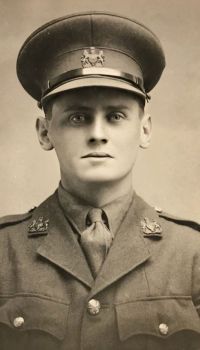
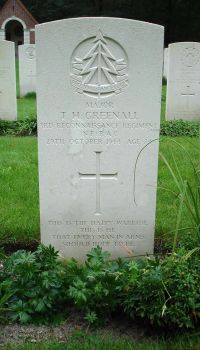
Biography
Terence Haigh was born on 21 May 1920 to Humphrey Greenall and his wife, Mabel Elizabeth (born Haig). They lived at Little Croft 21 Buidlon Road Guilford Esher, Surrey. Terence was their youngest son. His elder brother Greville was born nine years earlier, in 1911. In the 1920s, the family travelled to China several times, as shown by a 1925 passenger list from a ship from Liverpool to Shanghai. His father was then a cold store manager and eventually became a company director. Before the war, Terence joined the same family business and the 1939 register described him as a clerk at a “Produce Importer”.
School time
He was Head Boy at Felsted School in Essex where he studied from 1934 to 1939. His death notice in the school’s memorial book states:
Terence Greenall was one of the finest Felstedians of his generation; indeed he would be in the front rank in any generation. Head of the School, Head of Follyfield, Captain of Rugger, Captain of Tennis – these are his distinctions. But he was not one to whom distinction came easily. Everything he was and did he achieved by sheer strength of character, by courage, transparent honesty and sincerity, and by hard work. He demanded a high standard and himself set the pace which he expected others to follow. As an officer he was quickly marked out for promotion; and because he had disciplined himself to accept responsibility he was give almost more than his fair share. But he carried it to the end. He “died of a sudden attack of infantile paralysis on active service”. Very many remember him with admiration; many of us knew him as a personal friend. Admiration and friendship will keep his memory green’’.
The War
Terence enlisted on 14 October 1939, shortly after the start of WW2. He was assigned to the Royal Northumberland Fusiliers on 30 May 1941 and was eventually promoted to major (reg.no 189578).
In September 1944, Terence was part of the 3rd Reconnaissance Regiment, considered a reconnaissance unit. They stay in North Brabant, in Budel-Dorplein.
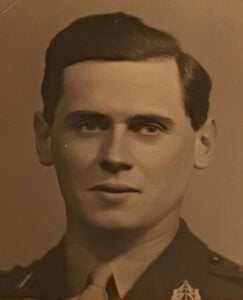
Brief history of Budel-Dorplein
In early 1892, some Belgians wanted to set up a zinc factory in Belgium. Since they did not get permission there, in the vicinity of Liège, they sought refuge in the Netherlands. They were Messrs Lucien and Emile Dor and Francois Sepulchre, all three from the Liège area. In their search for a location, they ended up in the municipality of Budel, an agricultural community with few economic prospects. On 7 July 1892, they bought about 628 hectares of land from the municipality of Budel. The nearby railway line Antwerp-Mönchengladbach and the Zuid-Willemsvaart formed an indispensable link in the supply and transport of raw materials (zinc ore, coal, building materials) and finished products.
By December 1892, 110 workers were already working in the rapidly built Kempensche Zinkfabriek.
This also necessitated housing and other facilities. One of the directors, Emile Dor, designed the village himself. The so-called “Le projet de Dorplein”.
On 5 September 1893, the “factory village” was named Dorplein as a lasting memory of the Dor brothers. The project was an ambitious plan for the time.
Emile Dor drew a village with all kinds of facilities such as a boys’ and a girls’ school, a bakery, a laundry and ironing establishment, a theatre hall, shop, infirmary, convent and chapel.
Through correspondence from Elsie Dor (wife of one of the Dor sons and the director of the zinc factory in 1944) to Terence Greenall himself (letter dated 30-11-1944) and later to his mother Mabel Greenall (letter dated 11-10-1945), it is known that Terence was billeted with the Dor family for five days in September 1944.
The Dor family gave shelter to many British officers, but Elsie writes that while more were sympathetic, Terence stood out particularly as he held his highest ideals, was sensitive and had a high sense of responsibility towards his men.
Some passages from Elsie Dor’s letters
“We wanted the officers to be as comfortable as possible in our little village, so we asked Maj. Greenall and Capt. Robinson to have dinner with us.
Capt. Robinson only appeared at 7.30pm and excused the major for never leaving his post before the last man returned from his mission. He would have no peace knowing that one of his men was still in danger.
At 10.30pm, Maj. Greenall finally appeared. We were very disappointed, but when he explained his reasons, so simple and clear, we understood immediately.
We were pleased to see how he enjoyed sitting in an armchair with armrests, for the first time since D-day, in a comfortable home. “It feels like home,” he said.
Everything he said was so interesting that it was 2.30am before anyone looked at the clock. This was around September 24, 1944.”
“We asked him if it still touched him personally when one of his men fell, to which he gave us the following wonderful answer: ‘you understand that I am their superior and every time one of my men falls, I think to myself, “Did I really do everything to avoid unnecessary danger?”‘
“We will never forget our joy when his unit liberated us, but also how sad we were that these brave soldiers were leaving us. Mostly expecting terrible fighting, danger from mines, shelling from the Germans etc.”
“We knew it would be a miracle if he escaped death. He hated the war, but he did his duty to the bitter end. You can be proud of him!”
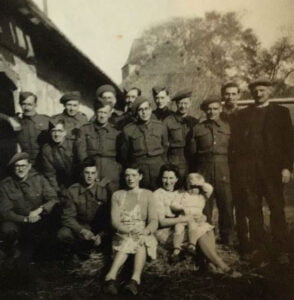
October 1944
On 1 October 1944, the Reconnaissance Corps, R.A.C., 3rd resides in Haps. Their task is to carry out patrols on the west side of the Meuse River. They have to guard this flank, passing through Haps, St. Agatha, Oeffelt and Beugen. They are in regular contact with the Dutch resistance and receive valuable information about German positions. There are frequent clashes with the Germans on these, often night patrols, who retreat behind the lines during the day and return to patrol at night.
On 12 October they are in St Hubert and, as reserves, wait to see what “Operation Aintree” will bring. This is the beginning of the Battle of Overloon for the British army.
From 15 October, they take over the position of the 4th Bn of the King’s Shropshires Light Infantry and carry out regular patrols around Vortum, Groeningen and Vierlingsbeek. They must prevent the Germans from counterattacking from the flank.
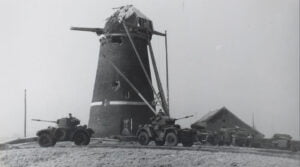
On 20 October 1944, 27-year-old Sgt.Frank Thomas Reed from Palmer’s Green, Middlesex, and Maj. Terence Haigh Greenall of “A” Company in their Humber MII Scout Car near Vierlingsbeek on reconnaissance. The dirt road, on which they ride, runs to farm “de Kiekuut”, parallel to the railway line towards Boxmeer.
Sgt. Reed and Maj. Greenall have been warned about mines and booby traps and scan the road with their trained eyes. They arrive at the level of the Pijls family home.
Suddenly there is a huge explosion, killing Sgt. Reed instantly and leaving Maj. Greenall seriously injured. The Humber MII Scout Car has hit a German mine, with terrible consequences.
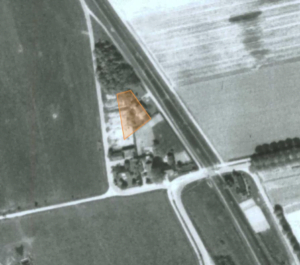
Both men were transported to the field hospital in Oploo, after which Sgt Reed was buried in the temporary cemetery on the Deurneseweg in Oploo. Maj. Greenall is nursed in the field hospital. It is not clear whether it is related to his injuries, but reports indicate that he dies on 29 October 1944 as a result of meningitis. So after nine days, the German mine claims a second victim after all. Major Terence Haigh Greenall is buried next to Sergeant Reed on the Deurneseweg in Oploo.
On 28 January 1946, both men are reburied at Overloon War Cemetery. Terence Haigh Greenall is buried in grave II.A.2. and Frank Thomas Reed lies next to him in grave II.A.1.
Humber MII Scout Car
As early as 1945, Harry van Daal from Overloon, among others, started collecting war equipment, which would be the beginning of the National War Museum in Overloon. In September 1945, an English delegation with Churchill tanks came to help bring the larger equipment to Overloon. The damaged Scouts Car of Sgt Reed and Maj. Greenall near Pijls’ home is picked up and placed outside in the park.
The Humber Scout Car stood outside in all weathers for decades, with the weather having free rein. This obviously did the vehicle no good and it disappeared into the background. A few years ago, the vehicle was fully restored and can again be seen at the War Museum as it would have looked before the explosion. Like almost all vehicles, it is now on display inside.
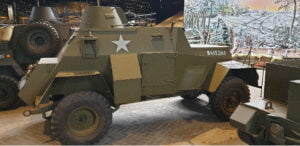
The Maj. Greenhallweg in Budel-Dorplein
While searching for information on Major Terence Haigh Greenall, we discovered that there is a street named after Maj. Greenhall. The municipality of Cranendonck previously stated:
“The Maj. Greenhallweg commemorates the English major Greenhall, under whose command Dorplein was liberated from German occupation on 20 September 1944.”
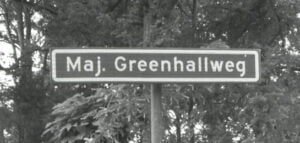
Records of the Municipality of Budel show that on 16 May 1955, an advisory committee on street naming was installed by the mayor. By council decision, the names of streets in Dorplein were officially established at the suggestion of the committee and two representatives of the Zinc Factory (Fr. Dor and D. Rooymans). There is a mention of a “Green Hallweg” after the captain or major who liberated the village. The correct rank and spelling then appear not so certain. By council decision of 2 May 1968, it was decided to add the title major to the street name for clarification. The street name “Maj. Greenhall Road” officially applied as of 1 December 1968.
Some doubt has arisen in recent years as to whether Major Terence Haigh Greenall was the actual liberator of Dorplein, but the street name is still there.
Letters from Elsie Dor from 1944 and 1945
Sources and credits
Mrs Angela Aziz, cousin major Greenall
Tonnie Ebben due to the bonnet of the Humber MII Scout Car in his museum “van Postzegel tot Tank”
Frank van Duin
Willem Kiggen and Wim Ogier of Heemkundekring “De baronie van Cranendonk”
Research Sue Reynolds and Oscar Huisman
